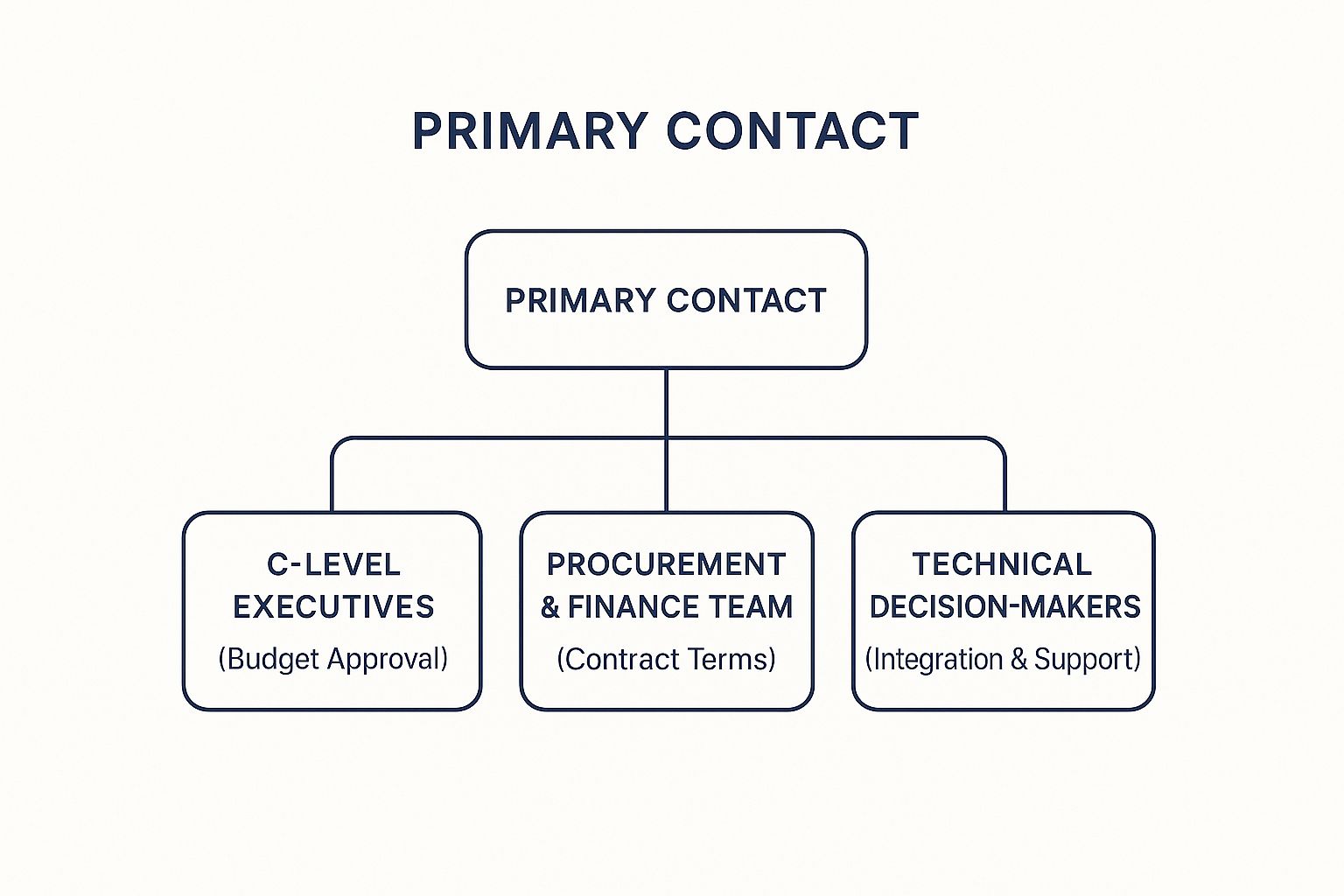6 Actionable Sales Playbook Examples for B2B Teams in 2025
Stop guessing. Explore 6 proven sales playbook examples (SPIN, Challenger, MEDDIC) with deep analysis and actionable tips to boost your B2B sales...
Stop guessing and start closing. Learn the 6 most important sales buying signals that reveal true purchase intent and accelerate your B2B sales cycle.
In B2B sales, knowing when a prospect is just curious versus when they’re ready to buy is a game-changer. Get it wrong, and you waste weeks on a deal that was never going to happen. Get it right, and you can speed up the sales cycle and focus on deals you can actually win.
Strong buying signals aren't just vague interest. They're specific questions and actions that show a prospect is seriously considering your solution. When a prospect asks about implementation timelines or wants to bring in their CTO, they're not just making small talk—they're figuring out how your product fits into their business.
This guide breaks down the most important sales buying signals you'll encounter. We’ll look at what each signal means, why it matters, and give you a clear plan on how to respond. You’ll learn how to spot these moments and use them to move deals forward.
One of the clearest sales buying signals is when the conversation turns to money. When a prospect asks specific questions about pricing, payment terms, or budget, they've moved past simple curiosity. They're now evaluating your product as a real option.

These questions are part of their internal buying process. They're building a business case, comparing you to competitors, and figuring out if they can get the purchase approved. Recognizing this signal is your cue to shift from discussing value to talking specifics.
When a prospect asks about cost, they’re telling you more than just their budget. Each question gives you a clue about their decision-making process and priorities.
Your response to pricing questions can either build momentum or stall the deal. The key is to connect price to value, not just throw out a number. Having a solid grasp of software pricing strategies that drive revenue growth is essential here.
Actionable Takeaways:
When a prospect goes from asking what your product does to wanting to see it in action, you've hit a key milestone. A request for a demo, free trial, or pilot is one of the strongest sales buying signals. It means they’ve moved past theory and are ready to see how your solution works for their specific problems.

This request is an investment of their time. They are committing resources to see if your claims hold up and to picture how your product would fit into their workflow. They're inviting you to prove your value and help them build their business case.
A demo or trial request is a clear sign of interest, but the specific wording tells you a lot about their priorities and where they are in the decision-making process.
How you handle a demo or trial request can make or break the deal. The goal is to deliver a tailored experience that addresses their specific needs, not a generic product tour.
Actionable Takeaways:
When your main contact starts introducing you to their colleagues, you've hit a major buying signal. An offer to connect you with executives or department heads means the deal is gaining internal traction. Your champion believes in your solution enough to put their own reputation on the line.
This signals that the conversation is moving from "what if" to "how to." Your contact knows they can't make the decision alone and needs to get buy-in from others. This is your cue to start navigating the entire buying committee, not just a single person.
An introduction to other stakeholders is a strategic move by your champion. Each new contact is a piece of the puzzle, and understanding their role is key to moving the sale forward.
The following diagram shows the typical stakeholders you might meet as the deal moves forward.

Each new introduction serves a purpose, from getting budget approval to finalizing the technical details.
Once you're introduced to new stakeholders, you need to adjust your approach. You're now selling to a group with different priorities.
Actionable Takeaways:
When a prospect switches from talking about features to discussing deployment, it’s one of the strongest sales buying signals. Questions about implementation timelines or onboarding show that they’re no longer thinking if they'll buy, but when and how to get started.

This shift signals mental ownership. The prospect is already picturing your product in their workflow and is figuring out the steps to make it happen. They're building a project plan, allocating resources, and aligning the purchase with their business goals.
Every question about implementation reveals the buyer's internal strategy and level of commitment. They’re trying to fit your solution into their business calendar.
How you handle these discussions can either build confidence or kill momentum. Your goal is to be a competent partner who can map out a clear path to success.
Actionable Takeaways:
When a prospect moves from discussing features to reviewing the contract details, it’s a definitive sales buying signal. This focus on terms, service level agreements (SLAs), and other conditions means they've mentally committed to the partnership. They are now making sure the legal and operational details fit their company's needs.
This is about more than just price; it's about risk, long-term partnership, and making sure everything runs smoothly. Active negotiation shows they're investing significant internal resources, often bringing in their legal or procurement teams. They're past the "if" and are now finalizing the "how."
Every requested change to the contract gives you a window into the prospect's priorities and potential internal hurdles. Understanding why they're asking for certain changes helps you address their core concerns and build trust.
Responding to negotiation points requires a balance of being firm and flexible. Your goal is to protect your company's interests while showing you’re a reasonable partner.
Actionable Takeaways:
When a prospect stops just liking your product and starts selling it for you internally, you've found a champion. This is one of the most powerful sales buying signals. They are no longer just a contact; they're an active advocate, putting their own credibility on the line because they believe in your solution.
This behavior means the deal has serious internal momentum. Your champion is doing the hard work of building support and overcoming objections when you’re not there. Recognizing and empowering this person is often the key to closing a complex deal.
The information a champion shares is a roadmap to closing the deal. Their actions and words give you priceless insight into the company's internal dynamics and decision-making process.
When you find a champion, your job shifts from selling to enabling. You need to make them look good and make it easy for them to advocate on your behalf.
Actionable Takeaways:
| Buying Signal | Implementation Complexity | Resource Requirements | Expected Outcomes | Ideal Use Cases | Key Advantages |
|---|---|---|---|---|---|
| Direct Questions About Pricing and Budget | Low - mainly communication-based | Minimal, mainly sales time | Clear purchase intent, budget alignment | Early budget evaluation and qualification | Clear signal of serious intent, drives urgency |
| Request for Product Demonstrations or Trials | Medium to High - requires preparation and customization | High - demos, trial support, technical resources | High engagement and interest, validation of fit | Complex products needing hands-on proof | Showcases product strengths, builds emotional connection |
| Introduction to Key Decision-Makers | Medium - coordination and preparation | Moderate - research and tailored messaging | Access to top stakeholders, faster decisions | Enterprise or complex sales with multiple stakeholders | Accelerates process, reveals organizational politics |
| Discussion of Implementation Timelines | Medium - requires planning expertise | Moderate - project management involvement | Visualize deployment, commitment to buying | Solutions with complex deployment phases | Creates momentum, uncovers challenges early |
| Negotiation of Terms and Conditions | High - legal and management involvement | High - legal, sales, and management time | Finalizes deal structure, confirms commitment | Advanced stage deals requiring contract customization | Enables value-based trade-offs, signals advanced stage |
| Internal Champion Advocacy Behaviors | Medium - relationship management | Moderate - ongoing support and communication | Higher win rates, insider knowledge | Complex or long sales cycles in large organizations | Dramatically increases close rates, accelerates cycle |
We've covered the landscape of B2B sales buying signals, and the bottom line is this: the best sales professionals are expert listeners. They don't just hear words; they understand what actions mean. The signals we've covered—from pricing questions to a champion's advocacy—are the clues that lead you to a closed deal.
Recognizing these signals is the first step, but how you respond is what truly matters. It’s about being a proactive partner who anticipates needs, not just a salesperson who waits for a request.
Let's boil it down to a few key principles:
The modern sales world is too complex to track everything manually. Relying on memory or notes to follow up on every hint is a recipe for missed opportunities. The top performers combine human intuition with technology.
This is where you gain a real competitive edge. Imagine getting an alert not just when a prospect asks about pricing, but also when their company's earnings call highlights a problem your solution solves. That’s the power of automated signal intelligence.
By using technology to monitor a wide range of sales buying signals—from financial reports to leadership changes—you free up your most valuable asset: your time. You can stop spending hours on research and start focusing on high-level strategy, like crafting the perfect response or coaching your champion.
The goal is to build a repeatable process. First, identify the signals that matter most. Second, understand the context. Finally, execute a planned, value-driven response. By embedding this system into your sales process, you move from passively waiting for deals to proactively creating them, ensuring you never miss a chance to turn a subtle hint into a signed contract.
Ready to stop searching for signals and start having them delivered directly to you? Salesmotion is the intelligence platform that automates the discovery of high-intent sales buying signals, so you can focus on what you do best: selling. Explore how Salesmotion can transform your pipeline today.
Stop guessing. Explore 6 proven sales playbook examples (SPIN, Challenger, MEDDIC) with deep analysis and actionable tips to boost your B2B sales...
Learn how B2B data enrichment transforms raw contacts into valuable insights. Discover strategies and tools to enhance your sales and marketing...
Explore inbound vs outbound sales to find the right strategy for your business. This guide provides a clear comparison with real-world scenarios and...